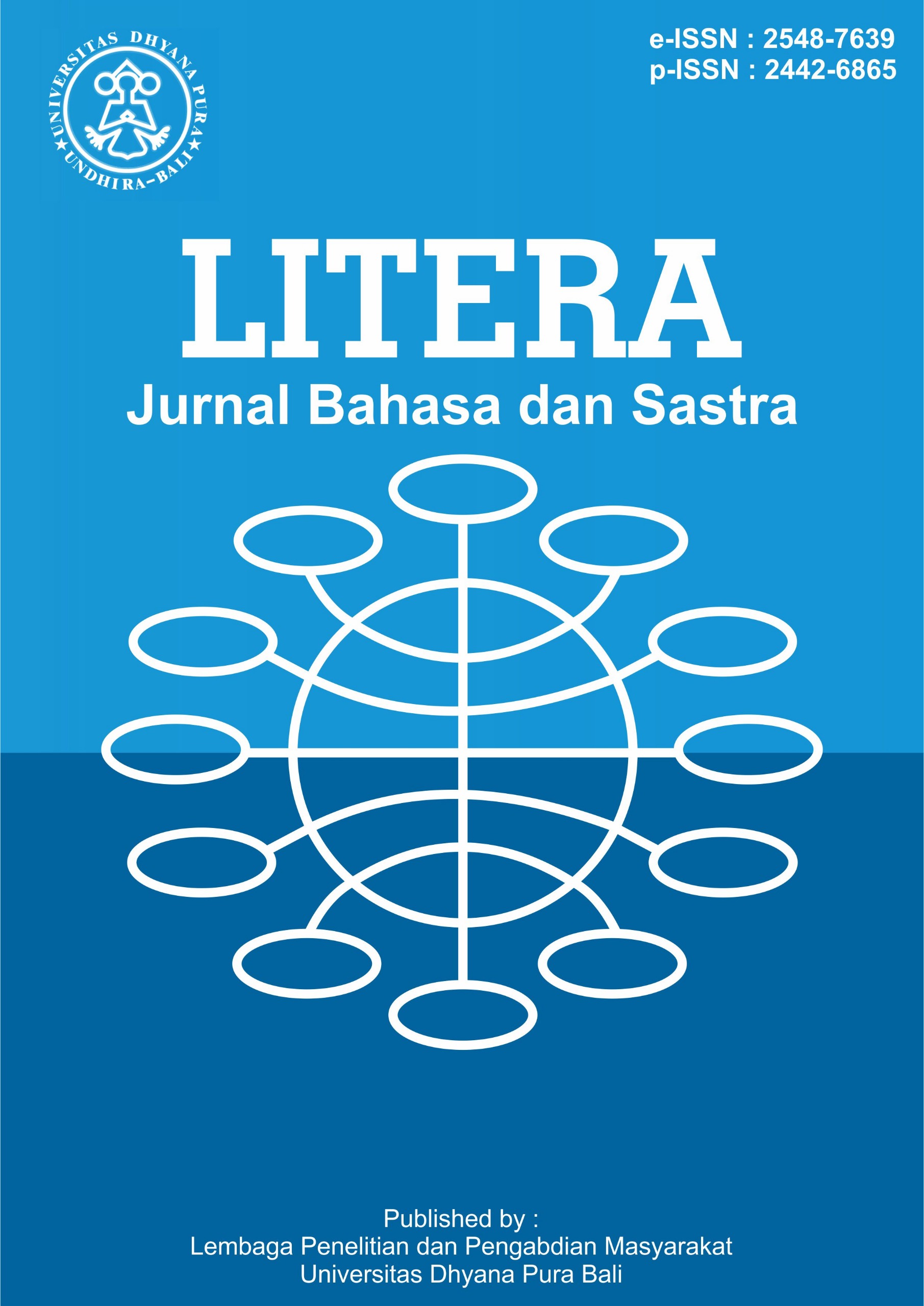The Impact of Emoji Use on Perception Differences in Online Conversations among Teenagers
DOI:
https://doi.org/10.36002/litera.v11i2.3901Keywords:
Emoji, Perception Difference, Teenagers, Online ConversationAbstract
In the digital era, teenagers now communicate more often through online platforms. One of the current growing phenomena is the use of emojis. Emojis act as nonverbal elements that can influence various aspects of the communication process. Emojis can affect the intonation and clarity of meaning of the message to be conveyed, without elements of sound or facial expressions, written messages are often ambiguous or even misperceived. Emojis are effective in reducing communication confusion by providing additional visual cues about the sender's intentions and emotions. This study aims to understand the phenomenon of emojis used in online conversations in depth and their impact on differences in perception among teenagers. This study utilized a qualitative research design with a case study approach among teenagers. The study's results showed a significant influence on differences in perception and perspective in the use of emojis among teenagers. So, it is important to understand the context and meaning of emojis to reduce the risk of misunderstandings and differences in perception in online communication in this digital era. Through a better understanding of the use of emojis, it is hoped that a more effective and harmonious communication environment can be created.
Downloads
References
Alburaidi, A. M. (2023). Gender Differences in the Use of Emojis Among Genders. International Journal of English Linguistics, 13(5), 45. https://doi.org/10.5539/ijel.v13n5p45
Bakhtiar, A., Rinata, B., Sukamto, K., Hidayat, S., & Pramono, S. (2022). Efektivitas Penggunaan Emoji Dalam Komunikasi Digital. Universitas Negeri Surabaya 2022, 620, 620–632. https://proceeding.unesa.ac.id/index.php/sniis/article/download/118/103
Butterworth, S. E., Giuliano, T. A., White, J., Cantu, L., & Fraser, K. C. (2019). Sender gender influences emoji interpretation in text messages. Frontiers in Psychology, 10(APR), 1–5. https://doi.org/10.3389/fpsyg.2019.00784
Cavalheiro, B. P., Prada, M., & Rodrigues, D. L. (2024). Examining the effects of reciprocal emoji use on interpersonal and communication outcomes. Journal of Social and Personal Relationships, 41(8), 2147–2168. https://doi.org/10.1177/02654075231219032
Chairunnisa, S., & A.S., B. (2017). Analysis of Emoji and Emoticon Usage in Interpersonal Communication of Blackberry Messenger and WhatsApp Application User. International Journal of Social Sciences and Management, 4(2), 120–126. https://doi.org/10.3126/ijssm.v4i2.17173
Derks, D., Fischer, A. H., & Bos, A. E. R. (2008). The role of emotion in computer-mediated communication: A review. Computers in Human Behavior, 24(3), 766–785. https://doi.org/10.1016/j.chb.2007.04.004
Evans, V. (2017). The Emoji Code The Linguistics Behind Smiley Faces and Scaredy Cats.
Flores-Salgado, E., & Castineira-Benitez, T. A. (2018). The use of politeness in WhatsApp discourse and move ‘requests.’ Journal of Pragmatics, 133(August), 79–92. https://doi.org/10.1016/j.pragma.2018.06.009
Guntuku, S. C., Li, M., Tay, L., & Ungar, L. H. (2019). Studying Cultural Differences in Emoji Usage across the East and the West | Proceedings of the International AAAI Conference on Web and Social Media. Proceedings of the Thirteenth International AAAI Conference on Web and Social Media, ICWSM. https://www.aaai.org/ojs/index.php/ICWSM/article/view/3224
Iansfri, Azzahra, and R. R. D. A. (2025). Faktor yang mempengaruhi minat membeli suatu produk dari penggunaan emoji dalam komunikasi pemasaran digital. 5(1), 81–88.
Isaac, L. (2019). Effects of Emoji Usage on Perceptions of Sender. https://repository.fit.edu/etd/193/
Kutsuzawa, G., Umemura, H., Eto, K., & Kobayashi, Y. (2022). Age Differences in the Interpretation of Facial Emojis: Classification on the Arousal-Valence Space. Frontiers in Psychology, 13(July). https://doi.org/10.3389/fpsyg.2022.915550
Manganari, E. E. (2021). Emoji Use in Computer-Mediated Communication. The International Technology Management Review, 10(1), 1. https://doi.org/10.2991/itmr.k.210105.001
Maulidina, D. H. (2021). PENGGUNAAN EMOJI DALAM KOMUNIKASI PEMBELAJARAN DARING MELALUI MEDIA WHATSAPP. Pharmacognosy Magazine, 75(17), 399–405.
Minich, M., Kerr, B., & Moreno, M. (2025). Adolescent Emoji Use in Text-Based Messaging: Focus Group Study. JMIR Formative Research, 9, 1–10. https://doi.org/10.2196/59640
Ningsih, L., Amran, A., & Dianto, I. (2024). INTERAKSI PERADABAN : Jurnal Komunikasi dan Penyiaran Islam Persepsi Mahasiswa Terhadap Penggunaan Emoticon Pesan WhatsApp Pada Program Studi Komunikasi dan Penyiaran Islam Pendahuluan. 61–82.
Novak, P. K., Smailović, J., Sluban, B., & Mozetič, I. (2015). Sentiment of emojis. PLoS ONE, 10(12), 1–22. https://doi.org/10.1371/journal.pone.0144296
Park, J., Baek, Y. M., & Cha, M. (2014). Cross-Cultural Comparison of Nonverbal Cues in Emoticons on Twitter: EVIDENCE from Big Data Analysis. Journal of Communication, 64(2), 333–354. https://doi.org/10.1111/jcom.12086
Peck, J., & Barger, V. A. (n.d.). Textual Paralanguage and Its Implications for Marketing Communications † Andrea Webb Luangrath.
PRATIWI, R. (2025). Semiotika digital dan penggunaan emoji dalam meningkatkan kejelasan komunikasi bisnis. March, 0–5.
Quhaj, A. (2024). PENGARUH PENGGUNAAN EMOJI WHATSAPP TERHADAP PEMAHAMAN PESAN, EKSPRESI EMOSIONAL, EFEKTIVITAS KOMUNIKASI, DAN REAKSI PADA GENERASI Z DI KALANGAN MAHASISWA STIKOM YOGYAKARTA DALAM KOMUNIKASI DIGITAL. Αγαη, 15(1), 37–48.
Rahayu, P. B., Cangara, H., Studi, P., Komunikasi, I., Hasanuddin, U., Studi, P., Komunikasi, I., Makassar, U. I., & History, A. (2024). Peran Artificial Intelligence dalam Transformasi Komunikasi Interpersonal: Peluang dan Tantangan di Era Digital. 5(4), 938–945.
Riordan, M. A. (2017). The communicative role of non-face emojis: Affect and disambiguation. Computers in Human Behavior, 76(November), 75–86. https://doi.org/10.1016/j.chb.2017.07.009
Telaumbanua, Y. A., Trima, N., Telaumbanua, N., Dwiyul, M., Gulo, B., Margaretha, D., Halawa, E., & Waruwu, E. K. (2023). The use of emojis on social media platforms in facilitating inter-cultural communication. Media and Communication Research, 4(8), 118–130. https://doi.org/10.23977/mediacr.2023.040803
Ummah, M. S. (2019). No 主観的健康感を中心とした在宅高齢者における 健康関連指標に関する共分散構造分析Title. In Sustainability (Switzerland) (Vol. 11, Issue 1). RED2017-Eng-8ene.pdf
Weissman, B., & Tanner, D. (2018). A strong wink between verbal and emojibased irony: How the brain processes ironic emojis during language comprehension. PLoS ONE, 13(8), 1–26. https://doi.org/10.1371/journal.pone.0201727
Downloads
Published
How to Cite
Issue
Section
License
Copyright (c) 2025 LITERA : Jurnal Bahasa Dan Sastra

This work is licensed under a Creative Commons Attribution-NonCommercial-ShareAlike 4.0 International License.
![]()
This work is licensed under a Creative Commons Attribution-NonCommercial-ShareAlike 4.0 International License.
















